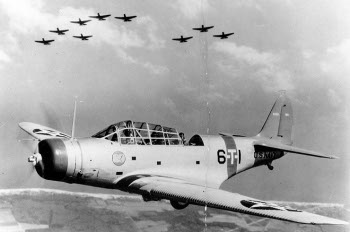![]() The Pacific War Online Encyclopedia
The Pacific War Online Encyclopedia
|
| Previous: Tazoe Noboru | Table of Contents | Next: TBF Avenger, U.S. Carrier Torpedo Bomber |

Douglas TBD-1
Devastator
| Crew | 2 or 3 |
| Dimensions | 50' by 35'6" by 15'1" 15.24m by 10.82m by 4.60m |
| Wing area | 422 square feet 39.2 square meters |
| Weight | 7,195-10,194 lbs 3264-4624 kg |
| Maximum speed | 206 mph (332 km/h) at 8000 feet (2400 meters) 192 mph (309 km/h) at sea level |
| Cruise speed | 128 mph 206 km/h |
| Landing speed | 69 mph 111 km/h |
| Climb rate | 12 feet per second 3.7 meters per second |
| Service ceiling | 19,700 feet 6000 meters |
| Power plant | 1 850 hp (634 kW) Pratt
& Whitney R-1830-64
Twin
Wasp 14-cylinder two-row radial engine |
| Armament | 1 0.30
machine gun on right side of nose 1 0.50 flexible machine gun in rear cockpit |
| External stores | 1 2216lb (1005 kg) 21" torpedo
or 1 1000lb (454 kg) bomb or 3 500lb
(227kg) bombs |
| Range | 435 miles (700 km) with full weapons load 716 miles (1150 km) maximum range |
| Fuel | 180 gallons 680 liters |
| Production | 130 produced from 10/5/37 to 11/39 by Douglas at El Segundo |
The Devastator is the aircraft that
became notorious for
its high losses at Midway.
It was
slow, clumsy, and not particularly rugged. It did not help
that the torpedo
carried by this aircraft required an attack run at 80 feet (24m) at not more
than 92
mph (148 km/h) at a range of not more than 1000 yards (910m), which made an attacking
Devastator
a sitting duck for both antiaircraft
and fighters. To add
insult to injury,
most of the torpedoes that did hit were duds. The Devastator was also
capable of horizontal bombing, but this required the bombardier to lie
prone in the belly of the plane, operating the Norden bombsight through a
belly window.
The design was selected on 3 February 1936 over a more traditional biplane design resembling the British Swordfish. The Devastator was very innovative for its day, with such features as partially retractable landing gear, and the production order of 110 aircraft was the largest the U.S. Navy had ever placed. Its adoption prevented the Navy from abandoning torpedo bombing entirely.
However, its day had passed by the time the TBD first saw
combat. It was almost thirty miles per hour (50 km/h) slower than its
Japanese counterpart, the B5N Kate, and had a much shorter range. The effective combat radius of a TBD was reckoned at
150 miles (240
km) with a torpedo or 175 miles (280 km) with a 1000 lb
(454 kg) bomb. This was considerably less than
half the theoretical maximum range, reflecting the higher use of fuel
during combat maneuvers and the need for a fuel reserve.
Production of the Devastator had already ended
when war broke out, but it took some time for its replacement, the TBF Avenger, to be available in sufficient
numbers to equip the carrier squadrons. However, Midway was the
Devastator's last important combat operation.
References
The Pacific War Online Encyclopedia © 2007, 2010, 2014 by Kent G. Budge. Index